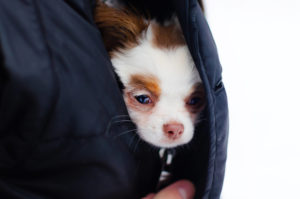 Winter has finally arrived, and with it, so have the shorter days and colder temperatures. As we feel the cold, so do our pets. What can we do to support our fur babies, so they too are safe and comfy during this time of the year?
Winter has finally arrived, and with it, so have the shorter days and colder temperatures. As we feel the cold, so do our pets. What can we do to support our fur babies, so they too are safe and comfy during this time of the year?
Keeping our pets warm, both during the day and at night, can be done by providing raised beds, warm blankets, coats and boots, and even by providing additional heat sources such as heat packs, wheat packs etc. These extra heat sources can become unexpected safety hazards, so be extra careful. For further information, please check out Keeping our Pets safe in winter.
Two main risks of wintertime for our pets are hypothermia and burns.
Hypothermia occurs when the body can no longer maintain its normal body temperature, and the body temperature falls below 35 degrees Celsius.
Pets more at risk of hypothermia are the very young and the elderly pets, smaller breeds, sick pets, pets with thinner coats, and skinny pets.
Risk factors include: overexposure of cold temperatures without a way to stay warm (e.g. being left out in the cold), swimming in cold water or having a wet coat, having undergone a general anaesthetic, or being unwell or having certain diseases (e.g. an underactive thyroid) that make it more difficult to maintain body temperature.
Signs of hypothermia start with shivering (until a stage where the body can no longer shiver), depression and weakness (seeming sleepy, lethargic, trouble walking), slowing of the breathing and heart rate, feeling cold to the touch, dilated pupils (the eyes look blacker), pale or bluish gums, then a loss of consciousness and coma.
First aid for hypothermia includes:
Remove your pet from the cold and put him/her in a warm room. Warming up the body by drying wet fur (either by towels and/or by a hairdryer set on a low setting), providing heat in the form of blankets, warm water bottles wrapped in towels (to prevent burns), giving warm fluids to drink (if the pet is still able to swallow properly), and taking your pet’s temperature every 10 minutes to assess the success of the warming process. Active warming with the hot water bottles etc. can be stopped when the body temperature reaches 37.5 degrees Celsius, but still keep them warm.
If you cannot raise the core body temperature at home through these first aid measurements, immediate veterinary attention is vital. However, even pets that do respond by warming up at home should be checked out by a vet as soon as possible as hypothermia can have detrimental effects on the Central Nervous System, Cardiovascular and Respiratory Systems and immune system.
Burns can occur in winter due to a pet being too close to a heat source. This can be an open fire or oil heater, or even a wheat pack or hot water bottle warmed up too much and not wrapped in a towel. The hot water in a hot water bottle can pose and extra danger if the bottle leaks the hot fluid. Burns can also occur when our pets chew on electric cords, for example, cords from electric blankets.
Burns can be graded in severity from first degree burns through to 3rd-degree burns.
For first degree burns from a hot surface or liquid, cool the area as soon as possible. Start with running cool water over the burned area, then apply a cold pack (such as frozen peas wrapped in a tea towel), ideally for a minimum of 20 -30 minutes, while making your way to our clinic for further treatments. Don’t use any ointments, creams etc. on the burned area.
Pets with second or third-degree burns, where the skin is partially or fully damaged, can go into shock and need immediate veterinary attention. Rinse with cool water as first aid, then cover the wound with a dry sterile non-sticky dressing (avoid dressings with loose fibres that can stick to the wound if possible) and bandage to hold the dressing in place, and come to see us immediately.
If you suspect your pet has been burned, immediately apply a cold pack (such as frozen peas wrapped in a tea towel) to the burned area, ideally for a minimum of 30 minutes. Remove your pet from the source of the burn (e.g. turn off electrical devices). Burns can progress and damage underlying tissue much more than visible at first glance, so after the immediate first aid application, come and see us as soon as possible for the best possible outcome for your pet. We can provide emergency treatments to combat shock and stabilise the patient, followed by wound management and supportive treatments, including pain relief, antibiotic support, fluids, nutritional support, and medical and surgical wound management as needed.
For any further advice or any other questions, please don’t hesitate to contact our friendly staff at Cronulla Veterinary Clinic, on 9527 2604.
